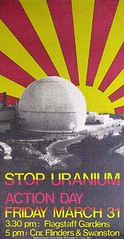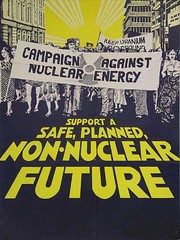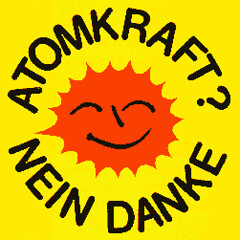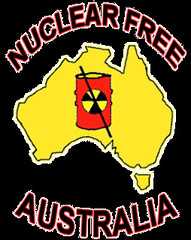
But in order for Australia to have a viable nuclear power industry, Ian Smith says four or five nuclear power plants would have to be built on the east coast.

"This would mean, power stations would go on the main grids and would supply electricity into those main grids. A normal fleet of four or five nuclear stations would produce something in the vicinity of 5,000 mega-watts of power," he said.
Q: How much power does a modern nuclear plant produce and how does that compare with typical coal, hydro power, wind power & solar power? Why do nuclear power, wind power & solar power all "cost" more (in cents per kWhr) than conventional fossil-fuel power?
A: How long is a piece of string? If you install enough wind or solar power stations you can easily compete with nuclear, but what you have is a difference of scale - wind and solar are generally smaller, but you can have more of them. Nuclear costs more because it is a very complicated and dangerous technology. Coal is also a dangerous technology, but it's not complicated. With nuclear, you've got all the mining and related hazards and then you've got the radioactivity that has to be contained - it's 2 to 3 times more expensive then coal. Nuclear will probably never really be cheap, simply because of the safety costs.

Nuclear power plants require vast amounts of water to keep them cool. Sea water is not viable due to its corrosive nature. Just where is all this fresh water supposed to be coming from in a country that barely has sufficient fresh water for its own population. Are we going to start building massive desalination plants next to these power stations and what will be the cost of those at the end of the day. The Howard goverment already says that desalination plants are to expensive to build for the amount of water they produce. Obviously to expensive for drinking water but not for producing nuclear power when you are sharing in the profits. Dubya and Dubious, what a team.
The thing that is deeply disturbing here is that now that I live in a country of approx. 86 million people which is serviced by eight nuclear power plants I have to wonder why Australia with only 20 million people requires 5 of them. Do our politicians really believe that all Australians are mug punters???
Germany is in the process of closing down their plants at vast cost. About the only thing most Germans are sure about right now is the dire need to abandon nuclear power, evidenced by the "Switch Off and Rethink" mantra stamped on billboards and in newspapers, buzzing from television sets, and crossing people's lips throughout the nation. And tough policies enacted by the red-green government have laid an incredible groundwork for that move -- not just for Europe's wealthiest nation to become nuclear-free in the next 15 years, but for renewable-energy suppliers to double their output to provide one-fifth of Germany's power within the same period.

By mid-century, the country expects to derive more than half of its power from renewables. Between now and 2020, when the last plant is scheduled to close, Germany's nuclear-power stations expect to produce about 6,000 additional tons of spent fuel. In the last five years, thanks to this singular piece of Green legislation, Germany has doubled its production of renewable fuels like wind, solar, geothermal, hydro, and biomass, which now comprise more than 10 percent of the total energy supply. Using essential free-market principles, the country has begun a radical re-mixing of its energy system which, if things go as planned or better, means Germany will be running on at least 65 percent renewables by mid-century.
Currently there are 435 atomic reactors generating electricity in 31 countries across the globe. They fill 6.5 percent of the world's total energy demand and use close to 70,000 tons of enriched uranium per year. Atomic plants produce one-sixth of the total electricity supply -- roughly on par with hydropower.
Just who stands to make all the money from the contruction and running of these new plants in Australia. Here in Germany the main supplier is Siemens, the Australian plants would be in the main be contructed by Westinghouse and Halliburton if Mr Howard had his way.
Westinghouse Electric Company provides fuel, services, technology, plant design, and equipment for the commercial nuclear electric power industry. Siemens owns Westinghouse. Rumsfeld is an ex Board of Directors and a major shareholder. Rumsfeld is, after all, the same man who was photographed shaking hands with Saddam Hussein back in the 80’s when America was selling him arms. If the reports are true, these may have included biological agents such as the germs for anthrax and botulism — from what I’ve read, the UN reports following the first Gulf War indicated that the biological strains which Hussein had in his possession were identical to those produced in the US.
So let’s make certain we have this right…the United States sells arms to other countries when it’s expedient for them to do so, and then turns around and criticizes those same countries for actually keeping them. Anyone else see something pathological about this?
Halliburton’s business dealings in Iran helped fund terrorist activities there—including the country’s nuclear enrichment program. It was Dick Cheney who directed Halliburton toward aggressive business dealings with Iran—in violation of U.S. law—in the mid-1990s, which continued through 2005 and is the reason Iran has the capability to enrich weapons-grade uranium.
So if Australia was to go ahead and have these 5 new nuclear stations built we would be looking at nothing more than lining the pockets of people like Bush,Cheney and Rumsfeld who profit so greatly from selling nuclear technology whilst putting Australia's eco system at potentially huge risk whilst at the same time adorning the east coast of Australia with five potential terrorist targets. No doubt there are some very lucrative offers for a place on the Board of Directors for Mr Howard should it all go ahead. Considering the state of superannuation in Australia now I guess he may well need a payment equivalent to that of which Rumsfeld was payed for sitting on the Westinghouse board of USD$190,000 a year. Nice work if you can get it.
I feel that Australia needs to have a full referendum on the signing of any agreements for the contruction of nuclear plants on Australian soil. This needs to take place after a lengthy environmental impact study which hopefully will last long enough to see that Howard, Bush, Rumsfeld and Cheney do not stand to make a cent from their implementation. Any agreements signed by Howard prior to the end of his term as Prime Minister need to be declared null and void until Australians as a whole vote on the issue. Australia has sufficient renewable resources in solar, hydro and wind to far outway any supposed benefits that nuclear power plants would bring us. Howard can no longer stand there and say that he is doing his bit to meet emission standards by trying to get these plants approved as his stance on the Kyoto Treaty shows it to be a bald face lie.

Keep Australia free of nuclear power plants and we will not face the dilemma that Germany is now facing as it tries to scale down and close its existing nuclear plants and dispose of thousands of tons of toxic waste. Don't be a mug punter be a stand up Aussie and nip this farce in the bud before we all end up paying for it and our children's children as well.
1 comment:
But what everybody has been missing (including you it seems) is that "Renewable Power" (ie: solar, wind, thermo, hydro, wave, tidal, geothermal) can be contributed on a micro level all over the grid. You don't need solar power stations for example, thousands of smaller contributions do the same job.
The solution is a government guarentee that everybody that can produce power in any way can sell it to the grid at a set percentage of its retail value.
In other words we need to start thinking of the grid as a collector of power as well as a means of distribution of power. A power market where everybody can buy and almost as many can supply.
Post a Comment